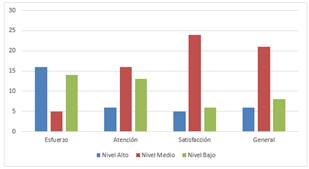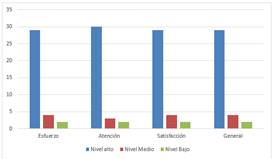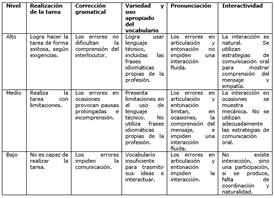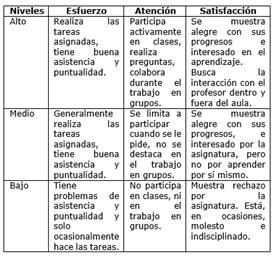My SciELO
Services on Demand
Journal
Article
Indicators
-
 Cited by SciELO
Cited by SciELO
Related links
-
 Similars in
SciELO
Similars in
SciELO
Share
Mendive. Revista de Educación
On-line version ISSN 1815-7696
Rev. Mendive vol.19 no.3 Pinar del Río July.-Sept. 2021 Epub Sep 02, 2021
Original article
Glossary of idioms. Its impact on motivation and speaking skill in English
1Escuela Ramal del MINAG. Pinar del Río. Cuba.
2Universidad de Pinar del Río "Hermanos Saíz Montes de Oca". Cuba
Idioms play an important role to achieve motivation with the aim of developing the speaking skill. However, the use of idioms is limited in the teaching -learning process of English in the teaching unit "Abel Santamaría Cuadrado" Surgical and Clinical Hospital of the Faculty of Medicine "Ernesto Che Guevara de la Serna" from Pinar del Río. With the aim to increasing the levels of motivation towards the learning of English and to developing the speaking skill in English of the nursing students of this teaching faculty a glossary of idioms using terms related to parts of the human body was elaborated, as well as exemplary conversations to learn and practice them. A guide of scientific observation and a pedagogical test were used in this work to evaluate the impact of the methodological procedure for the communicative teaching of the glossary, in the levels of motivation towards the learning of English and in the developing of the speaking skill. The practice of the idioms with terms related to the parts of the human body, seem to influence positively on their levels of motivation towards the learning of English and the speaking skill in English. Ninety-five percent of the students developed their speaking skill in English, when they could communicate orally and when they could make transpositions of the exemplary conversations elaborate.
Keywords: nursing; idioms; glossary; speaking; motivation
Introduction
Learning English is an effective means of exchanging information and carrying out medical assistance and collaboration plans. The subsystem of teaching medical sciences in Cuban universities attempts to develop communication skills in English through the curricular pathway in the nursing career.
In the past decade, there is a consensus in the scientific community and teaching as to the important role of motivation in the Teaching Learning process to stimulate the development of communicative competence(Alrabai, 2016; Ghani & Azhar, 2017; Lee & Lin, 2019; Lee, Gardner & Lau, 2020; Zarrinabadi, Mantou & Shirrzad, 2021) (Li, 2020).
Researchers such as You & Dö rnyei (2016) have shown that variables related to the immediate learning experience, such as the role of the teacher, the influence of the group and a successful experience and the contents of the curriculum exert a strong authority in the development of the motivation.
In this regard, idiomatic phrases play an important role in achieving motivation, because future professionals perceive them as content that makes sense and is important for the success of their professional communication(Wlodkowski, 2003). However, its use is limited in the Process of Teaching - Learning English at the Faculty of Medicine "Ernesto Che Guevara de la Serna" in the teaching unit of the Clinical Surgical "Abel Santamaria Cuadrado" Hospital of Pinar de Rio.
González (1995) refers that motivation is (…) "the inductive regulation of behavior, that is, that determines and regulates the direction of the target-object and the degree of activation or intensity of the behavior" (p.2).
For his part,Vallejo (2011)affirms that motivation " is composed of needs, desires, tensions, discomforts and expectations and that it constitutes a previous step to learning and considers it its motor" (p . 11).
There are several theories that try to explain motivation; however, the theory of self-determination is the theoretical support in this research.
Jang, Kim & Reeve (2016); Reeve, Ryan & Deci (2018); Ryan & Deci (2020)recognize this theory as the most comprehensive model of the motives that generate human development in education and personality psychology; It emphasized the value of intrinsic motivation in learning. This is the motivation that tries to promote with the idiomatic phrases that name parts of the human body, in the context of this research.
The theory of self - determination takes as its premise that individuals can strengthen their own motivation strategies by engaging in several auto regulatory ones, as set appropriate and achievable goals, implement learning strategies and monitoring and evaluating the fulfillment of their goals.
Managing motivation is essential during and after class. In order for students to learn, it is necessary to awaken their attention, to create interest in studying. A respect,Roberto De Caro (2009) warns that "the integration ofIdiomsto the Teaching Learning Process can be difficult and ineffective when it is not relevant or necessary to carry out the educational goals" (p. 121).
Idiomatic phrases or proverbs are set phrases and their meaning is generally deduced from the idea they convey and not from the literal meaning of the expression. In Spanish they are called sayings and idioms.
Saracho (2014) defines units as "lexical units formed by more than two graphic words at their lower limit, whose upper limit is at the level of the compound sentence" (p. 639).
Cooper (2008)states that these units are fixed or almost fixed, since there are verbal changes in some cases and there are also units that can change some of their elements. At the same time, they are idiomatic, that is, they have a different meaning from the meaning of the sum of their constituents.
In addition, the meaning has several nuances that are difficult to explain, so the specific context in which they are presented must be kept in mind, which is why it is proposed to exercise them through dialogued contexts presented by the English teacher or by the students themselves.
Studies onidiomsindicate that students show acceptance of their importance and have a positive attitude towards their learning(Al-Houti & Aldaihani, 2018). Others suggest the use of non-rote methods during their teaching (Rhonbi & Sadeghi, 2017; Yi, 2019).
The literature also relates the use of idioms oridiomswith communicative competence, which is defined as "the ability to use language or to communicate in a culturally appropriate way with the objective of constructing meaning and fulfilling social tasks effectively and fluency through long interactions"(Tarvin, 2014, p. 3).
The objective of this research is to raise the levels of motivation towards learning English, and to develop the ability of oral expression in nursing students of this teaching faculty, through the socialization of an elaborated glossary that contains idiomatic phrases with parts of the human body, and a methodological procedure for its communicative teaching.
Materials and methods
In the study conducted there was used as population 35 students of the course for workers 3rdyear of nursing Teaching Unit of the Hospital "Abel Santamaria Cuadrado" Hospital, registered in the Faculty of Medicine "Ernesto Che Guevara de la Serna".
As a sample for the practical feasibility study, the 15 students from brigade 2 of the same course and teaching unit were taken.
As independent variable the identified process methodology for using the glossary of idiomatic phrases in English, where to mention parts of the human body and, as dependent variables, the motivation for learning the English language and communication skills for speaking in nursing students.
A pre-experiment was carried out to record the state of motivation and the levels of development of oral expression before and after the application of the methodological procedure.
The methodological procedure for teaching communicative glossary of idiomatic phrases in English used was as follows: phrases (see appendix 1) are introduced through dialogues (see appendix 2) and authentically usually used in scenarios of professional activity of Bachelor of Nursing. This occurs as part of a section of the class entitled "The idiomatic phrase and the parts of the human body"
Initially, the dialogue is heard with a listening comprehension task. They are given a card with the idiomatic expression in English with several alternatives on the equivalent in Spanish so that they can identify the correct one, according to the audio-text. Then, work is done in pairs that consist of writing a similar sentence using the phrase introduced in the dialogue, which they first read and repeated aloud. In the third activity, students use the sentence written above in dialogues typical of the professional setting. At the end of the class there are exercises oriented which are offered in Spanish, through sentential contexts, for them to recognize how it is expressed in English. To evaluate them in the next class, they are asked to make sentences using the phrase in English and the gifted students are asked to establish a short dialogue using the phrase.
To collect information on the indicators of the dependent variables, the following methods were used:
Educational testing: It was used to study the level reached in oral expression in English for students 3rdyear of Nursing before and after the pre experiment.
It consisted of an interaction between nurses. The students received the cards in pairs and had two minutes for their self-preparation, without consulting or exchanging with the other. Then, they conducted the dialogue, which was recorded for later analysis and evaluation using an evaluation scale.
Card 1. You are a nurse in a hospital. You start working at 1 p.m. Now you are at the dining hall talking to the nurse in the morning shift about the events, patients and doctors at the Emergency Room in the morning.
Card 2. You are a nurse at a hospital. You have been working at the Emergency Room in the morning shift. Now you meet the nurse who will substitute you in the afternoon. Inform him / her about the events, patients and doctors.
The evaluation scale used was the following:
Note:The final result of the exam is determined by the level that predominates in all the evaluation criteria.
Scientific observation: It was used to assess the level of motivation towards learning English physician before and during use of the methodological procedure for communicative teaching idiomatic phrases parts of the body.
The following class observation guide was used to evaluate the indicators of motivation towards learning English.
Note:The high level is reached when at least two criteria evaluated as high and none as low are met. Medium, if the medium predominates. And low, when you have at least two criteria evaluated as low.
Statistical - mathematical: It was used the percentage calculation of descriptive statistics in analyzing the results of the techniques used in the initial and final diagnosis.
Results
The dialogued elaborated situations, through the communicative approach and work in pairs, they fostered learning in an environment of socialization and support and raised the level of development of oral expression in English, according to the interests and needs of the selected sample.
The following graph shows the data obtained from the application of the observation guide to classes, before the application of the methodological procedure. The number of students described 3rdyear of nursing reaching medium low motivation towards learning English high level.
The results indicate that only six students were highly motivated (gráfico 1), while eight showed very low levels of motivation.

Graph. 1 - Results of the levels of motivation towards learning English, before the use of the methodological procedure, using the observation guide to classes
The final diagnosis on motivation, as can be seen in graph 2, revealed that there was a significant change in the attitude of the students, with a majority showing high levels of effort, attention and satisfaction.

Graph. 2 - Results of the levels of motivation towards learning English, after the use of the methodological procedure, using the observation guide to classes
Table 1, shown below, describes the results of the level achieved in oral expression in English for students 3rdyear of Nursing at pre experiment to the disqualifies the educational testing. The table reveals a considerable improvement in the ability to interact orally in English of most of the students, once they have undergone training in the use of the glossary of idioms related to parts of the body, using the methodological procedure described above.
Table 1 - Results of the level of development of oral expression ability in the applied pedagogical test, as an initial measurement instrument and after communication training as a final measurement instrument
| Indicators | Results of the initial measurement | Final measurement results | ||||
|---|---|---|---|---|---|---|
| High | Half | Low | High | Half | Low | |
| Completion of the task | 1 | 11 | 2. 3 | 2o | 12 | 3 |
| Grammar correction | 1 | 11 | 2. 3 | 20 | 12 | 3 |
| Variety and appropriate use of homework vocabulary | 0 | 12 | 2. 3 | 22 | 10 | 3 |
| Pronunciation | 6 | 6 | 2. 3 | 24 | 8 | 3 |
| Interactivity | 6 | 6 | 2. 3 | 22 | 10 | 3 |
| Overall Result | 1 | 11 | 2. 3 | 22 | 10 | 3 |
Discussion
Participants in experiences about idiomatic phrases and their impact on motivation and oral expression seem to have experienced changes similar to those reported by international studies on the subject, in which students, as a result of the use of the glossary with parts of the human body and from interaction, they are more motivated by learning the English language and develop oral expression skills.
The pre-experiment carried out demonstrated the validity of the research, expressed in the results of the applied instruments and in the indicators used to measure motivation towards learning and the level of development of communicative competence for oral expression.
The novelty of this research is manifested in relation to the study of idiomatic phrases with parts of the human body and the development of a methodological procedure for their communicative teaching.
The study in Pinar de Rio, specifically in the teaching unit of the "Abel Santamaria Cuadrado Hospital" with students- workers 3rdyear nursing allowed to know the initial motivation of most of these students toward learning the English language , their previous inability to communicate, and limitations of the teaching unit to provide the teacher with computerized technological means.
Nursing students interact by mentioning the parts of the human body, an obvious potential to use idiomatic phrases with said parts, which facilitated the socialization of a glossary of these phrases and a methodological procedure for their teaching. This inquiry could promote other researchers as a more viable option to raise motivational levels towards learning the English language and developing oral expression.
By way of conclusion, it is the general opinion of the participants that the experience in relation to the use of the glossary with parts of the human body, by nursing students, and the methodological procedure, made it possible to raise the levels of motivation towards learning the English language and the development of oral expression in an environment of socialization and enjoyment.
This pedagogical experience, however, has limitations in terms of the relatively small sample , which should be larger in future research to be able to reach more solid conclusions regarding the use of idiomatic phrases and their impact on motivation and oral expression in English.
REFERENCES
Al-Houti, Sh. K. & Aldaihani, S.M. (2018). Letting the Cat out of the Bag: EFL College Students´ Attitudes towards Learning English Idioms. International Journal of Higher Education, 7(1), pp. 140 150. https://www.sciedupress.com/ijhe [ Links ]
Alrabai, F. (2016). The Effects of Teachers´ In-Class Motivational Intervention on Learners´ EFL Achievement. Applied Linguistics, 37(3), 307-333. https://academic.oup.com/applij/article-abstract/37/3/307/1741531?redirectedFrom=fulltext [ Links ]
Cooper, Th. (2008). Teaching Idioms. Foreign Language Annals, 31(2), pp. 255- 266. https://doi.org/10.1111/j.1944-9720.1998.tb00572.x [ Links ]
Ghani, M. & Azhar, S.W. (2017). Effect of Motivation, Willingness to Communicate (WTC), Self-Perceived Communicative Competence (SPCC) and L2 Anxiety on the Frequency of Use of English as L2. Journal of Educational Research, 20(1), pp. 157 -171. https://www.prdb.pk/article/effect-of-motivation-willingness-to-communicate-wtc-self-7342 [ Links ]
González, D. (Ed.). (1995). Teoría de la motivación y la práctica profesional. Ciudad de la Habana: Editorial Pueblo y Educación. [ Links ]
Jang, H.; Kim, EJ. & Reeve, J. (2016).Why students become more engaged or more disengaged during the semester: A self-determination theory dual-process model. Learning and Instruction, 1(43), pp. 27-38. https://doi.org/10.1016/j.learninstruc.01.002 [ Links ]
Lee, T., Gardner, D., & Lau, K. (2020). The effects of L2 motivational strategies: within and beyond the L2 classroom. Innovation in Language Learning and Teaching, 14(5), 451-465. https://doi.org/10.1080/17501229.2019.1620240 [ Links ]
Lee, T.,& Lin, S. (2019). English teachers´uses of motivational strategies beyond an established framework. Educational Research, 61(4), 451-468. https://doi.org/10.1080/00131881.2019.1677170 [ Links ]
Li, H. (2020). Motivational Strategies in English as Foreign Language Teaching: a research review. Equity and Access for Language Learners, 17(1), pp. 137-154. https://doi.org/10.18060/24393 [ Links ]
Reeve, J.; Ryan, R.; & Deci, E. (2018). Sociocultural inûuences on student motivation as viewed through the lens of self-determination theory. In G. Liem, & D. McInerney (Eds.). Big theories revisited 2 (pp. 3160). Charlotte, NC: IAP. [ Links ]
Rhonbi, Z. & Sadeghi, K. (2017). Improving English Language Learners´ Idiomatic Competence: Mode of Teaching Play a Role? Iranian Journal of Language Teaching Research, 5(3), pp. 61-79. https://eric.ed.gov/?id=EJ1156202 [ Links ]
Roberto De Caro, E. (2009). The Advantages and Importance of Learning and Using Idioms in English. Cuadernos de Lingüística Hispánica, (14), julio-diciembre, 2009, pp. 121-136 Universidad Pedagógica y Tecnológica de Colombia Tunja-Boyacá, Colombia [ Links ]
Ryan, R. & Deci, E. (2020). Intrinsic and extrinsic motivation from a self-determination theory perspective. Contemporary Educational Psychology, 61, https://doi.org/10.1016/j.cedpsych.2020.101860 [ Links ]
Saracho, M. (2014) ¿Te echo una mano con las expresiones idiomáticas? En N. Contreras (ed.). La Enseñanza del español como LE/L2 en el siglo XXI. (pp. 639-652). ASELE [ Links ]
Tarvin, L. (2014). Communicative Competence: Its Definition, Connection to Teaching and Relationship with Interactional Competence. University of Missouri: USA. https://doi.org/10.13140/RG.2.1.3214.2807 [ Links ]
Vallejo, G. (2011) El aprendizaje desde la perspectiva de la motivación profesional y las actitudes. MEDISAN (online), 15(3), pp. 363-368. Disponible en: http://bvs.sld.cu/revistas/san/vol_15_3_11/san14311.htm [ Links ]
Wlodkowski, R. (2003). Fostering Motivation in Professional Development Programs. New Directions for Adult and Continuing Education, (98), pp.39 -48. https://doi.org/10.1002/ace.98 [ Links ]
Yi, G. (2019). Teaching English Idioms to Chinese EFL Learners: A Cognitive Linguistic Perspective. English Language Teaching, 12(5), pp. 145 155. https://www.ccsenet.org/journal/index.php/elt/article/view/0/39170 [ Links ]
You, C. & Dörnyei, Z. (2016). Language Learning Motivation in China. Results of a Large-Scale Stratified Survey. Applied Linguistics , 37(4), pp.495-519. https://academic.oup.com/applij/article-abstract/37/4/495/1742097 [ Links ]
Zarrinabadi, N.; Mantou, N. & Shirrzad, M. (2021). Autonomy support predicts language mindsets: Implications for developing communicative competence and willingness to communicate in EFL classrooms. Learning and Individual Differences, 86. https://doi.org/10.1016/j.lindif.2021.101981 [ Links ]
Appendixes
Appendix 1- Glossary of language phrases naming parts of the human body. An example.
1. Phrases with the part of the body
Head(Head)
(To) be a swell-head person = Cocky person.
Eg .: He is a swell-headed person. He believes that he deserves everything.
(To) be a pig-headed = Stubborn, stubborn person.
Eg .: Georgeis a pig-headed.He never listens to reason.
(To) be a Headmaster = Sub Director of School
Eg.:Mr. Ferrer is a great headmaster.
(To) be head over hills in love with… = To be madly in love with…
Eg: Romeo was head over hills in love with Juliet. / I'm head over heels for you.
(To) be head and shoulders over… = Stand out, stand out
Eg: José Martí was head and shoulders over many writers of his time.
From head to foot / toe. = From head to toe, the whole body.
Eg: Mrs. Addan is doing the early shift. Now, she is bathing a patient from head to foot / toe.
(To) Eat their heads off = Eat a large amount of food.
Eg: Come to see the doctor again if you get a stomachache. Remember, don't eat their heads off. It's bad for your stomach.
(To) get through one's head = Get something in your head until you understand it.
Eg .: Betsy can't get it through her head that I must come to the hospital before 7 o´clock and ask permission to leave.
(To) go to one's head = 1. When drinking makes you dizzy.
Eg.: If I drink beer, it goes to my head. = 2. When a person's success goes to his head.
Eg .: Success went to his head and he thought he was infallible.
(To) hang one's head = Lower your head. Humble yourself and promptly obey what is commanded.
Eg .: The Venezuelan people should not hand its head . The whole people can fight against the imperialism to success.
(To) have black head = Have blackhead
Eg .: That guy needs a face cleaning. He has blackhead.
(To) have a good head for = Have a brain, be good (for something)
Eg.: My new neighbor has a good head for Math.
Heads or tails? = Heads or tails?
Eg.: I decided who had to go by saying, "Heads or tails?"
(To) head up = Head up. Be in charge of something.
Eg.: The students from our school headed up the meeting.
Knucklehead = Cork oak head, foolish person.
Eg .: The new nurse is such a knucklehead . She insists on arguing with the psychiatrist.
(To) lose one'ssenses = Losing your mind, losing your brain, going crazy.
Eg: The madman lost his senses because his wife was unfaithful to him.
(To) Mind your head = Be careful, be careful.
Eg.: Mind your head on that low door.
Two heads are better than one = Consulting with another is convenient.
Eg.: It's better if talk with Dr. Evans. Two heads are better than one
.(To) use one's head = Think things through, have common sense (use one's head)
Eg.: If you use your head you won't be in trouble again.
Appendix 2- Discussed situations
Dialog 4
In the dining room (12:35)
Mr. Brown is looking for a person.
A: Excuse me, sir. Are you Doctor Evans?
B: No, I'm Dr. Vinosky.
Doctor Evans and I are very different.
A: Really? What does he look like?
B: He's young and tall. In addition, he has black hair and brown eyes and he has strong arms, log legs, and big feet.
A: Oh! You really described Doctor Evans from head to foot. Thank you.
B: Not at all.
Received: October 08, 2020; Accepted: July 20, 2021











 text in
text in 





